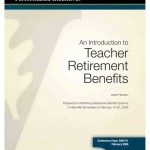An Introduction to Teacher Retirement Benefits
 Like most other state and local government employees, teachers participate primarily in defined benefit pension plans whose benefits are based on final average salaries and length of service. Such pensions have been replaced in many private sector firms by defined contribution pensions. A number of questions have arisen about the feasibility and desirability of continuing to rely on defined benefit pensions for teachers. These include (1) whether teacher pension plans are adequately financed to fulfill the commitments made to plan participants; (2) whether current pension plans are both fair to short-term and long-term teachers; and (3) whether these plans contribute to teacher shortages by encouraging early retirements and discouraging people from moving to schools where their skills and knowledge are most needed.
Like most other state and local government employees, teachers participate primarily in defined benefit pension plans whose benefits are based on final average salaries and length of service. Such pensions have been replaced in many private sector firms by defined contribution pensions. A number of questions have arisen about the feasibility and desirability of continuing to rely on defined benefit pensions for teachers. These include (1) whether teacher pension plans are adequately financed to fulfill the commitments made to plan participants; (2) whether current pension plans are both fair to short-term and long-term teachers; and (3) whether these plans contribute to teacher shortages by encouraging early retirements and discouraging people from moving to schools where their skills and knowledge are most needed.
This paper (1) presents basic information on teacher retirement plans; (2) discusses differences in the legal and economic context for public and private sector pensions that are important considerations in plan design; and (3) introduces issues related to financial sustainability, teacher mobility, and teacher shortages. The paper also provides an overview of key differences between defined benefit and defined contribution plans. It highlights the fact that the boundaries between various types of pensions are porous, and plans can be designed to include a variety of features depending on the objectives being sought. The paper also discusses one form of defined benefit pension, the cash balance plan, that has features normally found in both defined benefit and defined contribution programs. Cash balance plans have replaced some traditional defined benefit plans in private firms but have received almost no attention in the public sector.
To read this paper, please click here.
Connect with Vanderbilt
©2025 Vanderbilt University ·
Site Development: University Web Communications